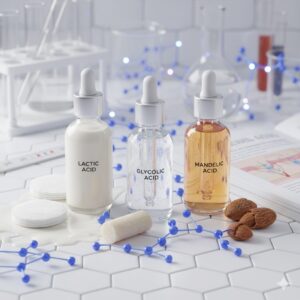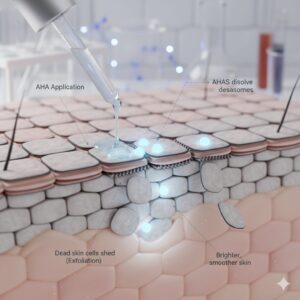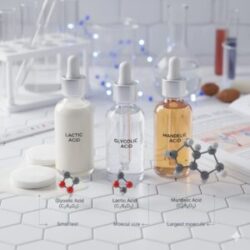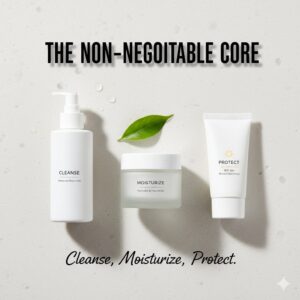Alpha Hydroxy Acids (AHAs):
If you’re looking for smoother, brighter, more youthful-looking skin, alpha hydroxy acids (AHA Acids) are probably on your radar. These chemical exfoliants have been used in skincare for decades, and for good reason—they deliver real, visible results.
But here’s where it gets confusing: there are several different types of AHAs, and they don’t all work the same way. Glycolic acid, lactic acid, and mandelic acid are the three most popular, and choosing the wrong one for your skin type can lead to irritation and disappointment.
As someone who’s spent years analyzing cosmetic ingredients, I’m going to break down exactly how these acids differ, which one is right for your skin, and how to use them safely for maximum results.
What Are Alpha Hydroxy Acids (AHAs)?
Alpha hydroxy acids are a group of naturally occurring acids derived from various foods. They’re water-soluble, which means they work on the skin’s surface rather than penetrating deep into pores like their oil-soluble cousin, salicylic acid (a BHA).
AHAs work primarily through exfoliation. They break down the bonds between dead skin cells on your skin’s surface, allowing these cells to shed more easily. This reveals the fresh, healthy skin underneath and triggers your skin to produce new cells faster.

The Science of How AHAs Work
When you apply an AHA to your skin, it loosens the “glue” (desmosomes) that holds dead skin cells together. This process, called desquamation, is happening naturally all the time, but AHAs accelerate it significantly.
According to the American Academy of Dermatology, AHAs can also stimulate collagen production in the deeper layers of skin when used consistently over time. This makes them valuable not just for surface improvements but for long-term anti-aging benefits as well.
The effectiveness of an AHA depends on three key factors:
- Molecular size: Smaller molecules penetrate deeper and work faster (but can be more irritating)
- Concentration: Typically ranges from 5% to 30% in skincare products
- pH level: AHAs work best at a pH of 3.0-4.0
Glycolic Acid: The Powerful Performer
Glycolic acid is derived from sugar cane and is the smallest AHA molecule, which makes it the most powerful—and potentially most irritating.
How Glycolic Acid Works
Because of its tiny molecular size (about 76 daltons), glycolic acid penetrates skin quickly and deeply. This means:
- Faster visible results
- More effective exfoliation
- Better penetration into the epidermis
- Higher potential for irritation
Glycolic acid is particularly effective at breaking down the bonds between skin cells, making it excellent for addressing multiple skin concerns simultaneously.
Benefits of Glycolic Acid
Powerful Exfoliation: Removes dead skin cells more effectively than larger AHA molecules, revealing brighter, smoother skin.
Anti-Aging Effects: Stimulates collagen production and reduces the appearance of fine lines and wrinkles with consistent use.
Hyperpigmentation Treatment: Effectively fades dark spots, sun damage, and post-inflammatory hyperpigmentation by accelerating cell turnover.
Improved Texture: Smooths rough, uneven skin texture and reduces the appearance of large pores.
Enhanced Product Absorption: By removing the barrier of dead skin cells, glycolic acid allows other skincare products like serums and moisturizers to penetrate more effectively.
Who Should Use Glycolic Acid
Glycolic acid is best for:
- Normal to oily skin types
- Those with thicker, more resilient skin
- People dealing with stubborn hyperpigmentation
- Anyone wanting aggressive anti-aging results
- Experienced users of chemical exfoliants
Who Should Avoid or Be Cautious
- Very sensitive or reactive skin
- People with rosacea or eczema
- Those with thin or compromised skin barriers
- First-time AHA users (start with something gentler)
- Anyone with active inflammation or wounds
Typical Concentrations
- At-home products: 5-10% for daily use, up to 30% for weekly treatments
- Professional peels: 30-70%, performed by licensed professionals only
Research published in the Journal of Cosmetic Dermatology shows that glycolic acid at concentrations of 10% and above can significantly improve signs of photoaging when used consistently over 12 weeks.
Lactic Acid: The Gentle Middle Ground
Lactic acid, derived from milk (though synthetic versions are common and vegan-friendly), has a slightly larger molecular size than glycolic acid, making it gentler while still effective.
How Lactic Acid Works
With a molecular weight of about 90 daltons, lactic acid penetrates more slowly than glycolic acid. This means:
- Gentler exfoliation
- Less irritation potential
- More suitable for sensitive skin
- Still delivers excellent results
What makes lactic acid special is that it’s also a humectant, meaning it attracts and retains moisture. This makes it less drying than other AHAs.
Benefits of Lactic Acid
Gentle Exfoliation: Effectively removes dead skin cells without the harshness of glycolic acid.
Hydrating Properties: Unlike most exfoliants, lactic acid actually helps skin retain moisture, making it ideal for dry skin types.
Brightening Effects: Fades dark spots and evens skin tone, though slightly more slowly than glycolic acid.
Improved Skin Texture: Smooths rough patches and refines skin texture with regular use.
Suitable for Sensitive Skin: The larger molecule size means slower penetration and less irritation.
Anti-Aging Benefits: Stimulates collagen production and improves skin firmness, similar to how peptides work, though through different mechanisms.
Who Should Use Lactic Acid
Lactic acid is ideal for:
- Dry or dehydrated skin
- Sensitive or reactive skin types
- First-time AHA users
- Those with mild rosacea (with caution)
- Anyone wanting gentler exfoliation
- People with compromised skin barriers
Typical Concentrations
- Beginner-friendly: 5% for daily use
- Standard strength: 8-10% for regular use
- Advanced: 12-15% for experienced users
- Professional treatments: Up to 30%
According to a study in the International Journal of Dermatology, lactic acid at 12% concentration showed significant improvement in skin texture, fine lines, and hyperpigmentation with minimal irritation compared to glycolic acid at the same concentration.
Mandelic Acid: The Sensitive Skin Solution
Mandelic acid, derived from bitter almonds, is the largest of the three common AHAs we’re discussing. Its larger molecular size makes it the gentlest option.
How Mandelic Acid Works
With a molecular weight of about 152 daltons (nearly twice that of glycolic acid), mandelic acid:
- Penetrates very slowly
- Causes minimal irritation
- Works more gradually but safely
- Can be used by almost anyone
Interestingly, mandelic acid also has mild antibacterial properties, making it particularly useful for acne-prone skin.
Benefits of Mandelic Acid
Extremely Gentle: The slowest penetration rate means the lowest risk of irritation, making it suitable even for very sensitive skin.
Antibacterial Properties: Helps reduce acne-causing bacteria, making it excellent for acne-prone skin.
Safe for Darker Skin Tones: Less risk of post-inflammatory hyperpigmentation, which can be a concern with stronger AHAs on melanin-rich skin.
Improves Texture: Smooths skin and refines pores without causing significant irritation.
Addresses Multiple Concerns: Works on aging, acne, and hyperpigmentation simultaneously, though more gradually.
Can Be Combined Easily: Its gentle nature makes it easier to use alongside other active ingredients like retinol or vitamin C.
Who Should Use Mandelic Acid
Mandelic acid is perfect for:
- Very sensitive or reactive skin
- Darker skin tones concerned about PIH
- Rosacea-prone skin (with medical guidance)
- Acne-prone skin, especially hormonal acne
- Those new to chemical exfoliation
- Anyone with a compromised skin barrier
Typical Concentrations
- Daily use: 5-10%
- Regular treatment: 10-15%
- Professional peels: 20-40%
Research in the Journal of Clinical and Aesthetic Dermatology found that mandelic acid was as effective as salicylic acid for treating acne but with significantly less irritation and a lower risk of post-inflammatory hyperpigmentation.
Side-by-Side Comparison
Let me break down the key differences in an easy-to-understand way:
Molecular Size
- Glycolic: Smallest (~76 daltons) – Fastest penetration
- Lactic: Medium (~90 daltons) – Moderate penetration
- Mandelic: Largest (~152 daltons) – Slowest penetration
Potency (Fastest to Slowest Results)
- Glycolic acid
- Lactic acid
- Mandelic acid
Irritation Potential (Highest to Lowest)
- Glycolic acid
- Lactic acid
- Mandelic acid
Best For Specific Concerns
Anti-Aging & Deep Wrinkles: Glycolic acid (most aggressive collagen stimulation)
Dry, Dehydrated Skin: Lactic acid (hydrating properties)
Sensitive Skin: Mandelic acid (gentlest option)
Hyperpigmentation on Fair Skin: Glycolic or lactic acid
Hyperpigmentation on Dark Skin: Mandelic acid (lowest PIH risk)
Acne: Mandelic acid (antibacterial properties) or glycolic acid (deep penetration)
First-Time Users: Mandelic acid, then graduate to lactic, then glycolic if desired
Speed of Results
- Glycolic: Visible results in 2-4 weeks
- Lactic: Visible results in 4-6 weeks
- Mandelic: Visible results in 6-8 weeks
How to Choose the Right AHA for Your Skin
The best AHA for you depends on several factors:
Consider Your Skin Type
Oily/Thick Skin: Can typically handle glycolic acid well. Start with 8-10% and increase if tolerated.
Normal Skin: Can use any of the three. Lactic acid is a safe, effective middle ground.
Dry Skin: Lactic acid is ideal due to its hydrating properties. Its moisture-retaining abilities work similarly to how hyaluronic acid provides hydration.
Sensitive Skin: Start with mandelic acid. Only graduate to lactic if mandelic becomes too gentle.
Combination Skin: Lactic or mandelic acid work well. You can also use different acids on different areas.

Consider Your Skin Concerns
Primary Concern: Aging First choice: Glycolic acid Alternative: Lactic acid (if skin is dry or sensitive)
Primary Concern: Hyperpigmentation Fair skin: Glycolic or lactic acid Medium to dark skin: Mandelic acid
Primary Concern: Acne First choice: Mandelic acid (antibacterial) Alternative: Glycolic acid (if skin isn’t too sensitive)
Primary Concern: Dryness + Texture Best choice: Lactic acid
Primary Concern: Sensitive Skin + Any Issue Best choice: Mandelic acid
Consider Your Experience Level
Complete Beginner: Start with mandelic acid at 5% Some Experience: Try lactic acid at 8-10% Experienced with Acids: Glycolic acid at 10% or higher
How to Use AHAs Safely and Effectively
AHAs can be transformative when used correctly, but they can also cause damage if misused. Here’s how to do it right.
Starting Your AHA Journey
Week 1-2: Apply once or twice per week only. Your skin needs time to adapt.
Week 3-4: If no irritation, increase to 3 times per week.
Week 5-6: Can increase to every other night if desired.
Week 7+: Some people use AHAs nightly, but every other night is sufficient for most.
Many people find their sweet spot is 3-4 times per week rather than daily use.
Application Guidelines
- Always apply to clean, dry skin: Wait 20-30 minutes after cleansing if your skin is damp
- Use at night: AHAs increase sun sensitivity
- Start with lower concentrations: You can always increase later
- Apply a thin, even layer: Avoid the eye area and any broken skin
- Wait before applying other products: Give the AHA 10-15 minutes to work at its optimal pH
- Follow with a good moisturizer: AHAs can be drying, so support your skin barrier with ceramides
- Use sunscreen religiously: This is non-negotiable with AHA use
The Importance of pH
AHAs work best at a pH between 3.0 and 4.0. According to the FDA’s guidance on alpha hydroxy acids, products formulated outside this range are less effective for exfoliation, though they may still provide other benefits.
When shopping, look for products that:
- Disclose their pH (ideally 3.5-4.0)
- Have AHAs listed high in the ingredient list
- Don’t contain conflicting ingredients that might raise the pH
What Not to Do
Don’t mix with other acids initially: Avoid using AHAs with BHAs, vitamin C, or other exfoliants when starting out.
Don’t use on compromised skin: Skip AHAs if you have active breakouts with open wounds, severe inflammation, or a damaged barrier.
Don’t over-exfoliate: More is not better. Over-exfoliation leads to a damaged barrier, sensitivity, and ironically, worse skin.
Don’t skip sunscreen: AHAs make your skin more vulnerable to UV damage. Always use SPF 30 or higher daily.
Don’t use right before sun exposure: Avoid using AHAs the morning before spending extended time outdoors.
Combining AHAs with Other Ingredients
Once your skin has built tolerance to AHAs, you can strategically combine them with other actives.
Safe Combinations
AHAs + Hyaluronic Acid: Excellent pairing. AHAs exfoliate while HA hydrates. Apply AHA first, wait, then apply HA.
AHAs + Niacinamide: Great combination for addressing multiple concerns. However, some people experience flushing when these are used together immediately. If this happens, use them at different times of day.
AHAs + Ceramides: Perfect partnership. AHAs can compromise the barrier temporarily, while ceramides support and repair it.
AHAs + Peptides: Both have anti-aging benefits through different mechanisms. Use AHAs at night and peptides in the morning, or apply peptides after your AHA has absorbed.
AHAs + Antioxidants: Vitamin E, green tea extract, and other antioxidants work well with AHAs and can help minimize potential irritation.
Cautious Combinations
AHAs + Retinol: Both are powerful and can be irritating. Options:
- Use on alternate nights
- Use AHAs in the morning, retinol at night
- Use only a few times per week each
- Wait until you’ve built tolerance to both individually
AHAs + Vitamin C: Can work together but the pH considerations are tricky. The low pH needed for vitamin C efficacy is similar to what AHAs need, but using both at once can be irritating. Consider using vitamin C in the morning and AHAs at night.
AHAs + BHAs: Both are exfoliants, so using together increases irritation risk. If combining:
- Use BHAs in oily areas, AHAs in dry areas
- Alternate days
- Use products specifically formulated with both at appropriate concentrations
Avoid Combining With
AHAs + Benzoyl Peroxide: Can be highly irritating and may reduce the efficacy of both ingredients.
AHAs + Physical Exfoliants: Using scrubs, brushes, or devices while using AHAs is overkill and will damage your skin.
AHAs + High-Strength Retinoids: Prescription retinoids are already aggressive. Adding daily AHAs is usually too much.
Managing Side Effects
Even with careful use, you might experience some adjustment symptoms.
Normal Adjustment Effects
- Mild tingling or slight stinging during application (should subside within a minute)
- Slight redness that fades within 30 minutes
- Increased sensitivity for the first few weeks
- Minor dryness or flaking as your skin adjusts
These are generally manageable and improve as your skin builds tolerance.
Signs You’re Over-Exfoliating
- Persistent redness or inflammation
- Burning sensation that doesn’t stop
- Increased breakouts
- Extreme dryness or flaking
- Skin feels tight and uncomfortable
- Increased sensitivity to all products
If you experience these signs:
- Stop using AHAs immediately
- Focus on gentle, hydrating products
- Use rich moisturizers and occlusives
- Be religious about sunscreen
- Give your skin 1-2 weeks to recover before reintroducing AHAs at a lower frequency
Serious Reactions
Seek medical attention if you experience:
- Severe burning or pain
- Blistering or peeling
- Significant swelling
- Signs of infection
- Severe allergic reaction
AHAs for Different Ages
In Your 20s
Focus: Prevention and maintenance
- Best choice: Lactic or mandelic acid at lower concentrations (5-8%)
- Frequency: 2-3 times per week
- Goal: Maintain smooth texture, prevent early signs of aging

In Your 30s
Focus: Early anti-aging and maintaining radiance
- Best choice: Lactic acid at 8-10% or glycolic acid at 8%
- Frequency: 3-4 times per week
- Goal: Address early fine lines, maintain even tone, prevent deeper aging signs
In Your 40s and Beyond
Focus: Addressing established aging signs
- Best choice: Glycolic acid at 10-12% (if tolerated) or lactic acid at 10-12%
- Frequency: 4-5 times per week or as tolerated
- Goal: Stimulate collagen, reduce wrinkles, improve texture and tone
Regardless of age, your skin’s tolerance matters more than your chronological age.
Professional vs. At-Home AHA Treatments
At-Home Products (5-15% AHAs)
Pros:
- Affordable
- Convenient
- Lower risk
- Gradual, sustainable results
- Can be part of regular routine
Cons:
- Slower results
- Less dramatic improvement
- Requires consistency and patience
Professional Peels (30-70% AHAs)
Pros:
- Dramatic, fast results
- Addresses deeper concerns
- Professional oversight
- More controlled application
Cons:
- Expensive (typically $100-300 per session)
- Requires downtime
- Higher risk of complications
- Needs multiple sessions
According to the American Society for Dermatologic Surgery, professional chemical peels can significantly improve photoaging, but they recommend maintaining results with appropriate at-home care, including lower-concentration AHA products.
For most people, consistent at-home use delivers excellent results without the cost and downtime of professional treatments.
Common AHA Myths Debunked
Myth 1: “AHAs Thin Your Skin”
This is false. While AHAs remove the top layer of dead cells, they actually stimulate collagen production and increase the thickness of the living skin layers beneath. Long-term, controlled use of AHAs makes skin stronger, not thinner.
Myth 2: “You’ll Purge with AHAs”
Unlike retinoids, AHAs don’t typically cause purging. If you break out when starting AHAs, it’s more likely:
- A reaction to other ingredients in the product
- Over-exfoliation causing irritation
- Using a concentration too high for your skin
Myth 3: “Natural AHAs Are Better”
The source doesn’t matter as much as the formulation. What matters is:
- The type of AHA
- The concentration
- The pH
- The overall formulation
Synthetic AHAs work identically to naturally derived ones.
Myth 4: “You Can’t Use AHAs in Summer”
You can use AHAs year-round, but you must be diligent about sunscreen. Some people prefer to reduce frequency or concentration during peak sun exposure months, but it’s not necessary if you’re protecting your skin properly.
The Bottom Line on AHAs
Alpha hydroxy acids are among the most effective, research-backed ingredients in skincare. When chosen and used correctly, they can dramatically improve:
- Skin texture and smoothness
- Fine lines and wrinkles
- Hyperpigmentation and uneven tone
- Dullness and lack of radiance
- Signs of sun damage
The key is matching the right AHA to your skin:
- Glycolic acid: For experienced users with resilient skin wanting aggressive results
- Lactic acid: For most people seeking effective but gentler exfoliation
- Mandelic acid: For sensitive skin, darker skin tones, or acne-prone skin
Start slowly, be patient, and always use sunscreen. Give your chosen AHA at least 8-12 weeks before deciding if it’s working for you.
Remember, healthy skin is about finding the right balance for your individual needs. AHAs are powerful tools, but they work best as part of a comprehensive routine that includes cleansing, hydration, barrier support, and sun protection.
If you approach AHAs with knowledge, respect, and patience, they can become one of the most valuable components of your skincare routine, delivering results that continue to improve over time.



